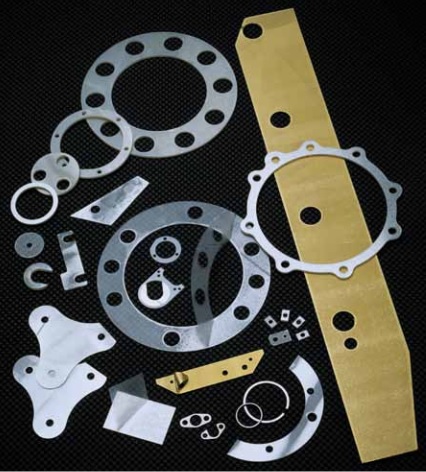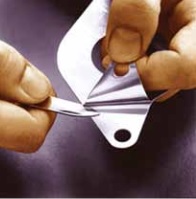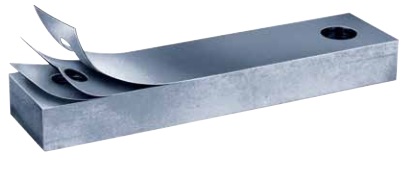Shims? Make Mine Laminated!
by Russel R. Radant, Chief Engineer, Spirol International Corporation

Laminated shims make life easier for designers and machine operators, as long as they're properly specified.
It's often quicker and less expensive to use a shim, a thin piece of metal or composite, to level a machine tool or make components fit together than grinding and machining to make the same mechanical adjustments. Shims act like those folded pieces of paper people place under table legs to prevent the table from wobbling. They are also used to quell vibrations and silence noisy equipment. But laminated shims are more versatile and economical than silvers of paper or machined wedges.
Laminated Shims
Laminated shims have peelable layers of metal or composite which are removed until the shim has the proper thickness Adjusting them is as easy as peeling off lamination with a knife, or in the case of some materials, using no tool at all. They are built up from layers of precision-gauge metal foil or composites. Layers are bonded into a rigid structure that appears and functions as a solid sheet or plate. The finished shims withstand reasonable handling, including shearing and machining.
Laminated shims are produced by surface-bonding layers of precision-metal foils or composite films and resin adhesive into sheets. The foils can be aluminum, stainless steel, carbon steel , and brass, among others. Final shims range from 0.006" to 0.250" thick. The bond is made by heat and pressure, which hardens and reduces the resin to a point where it is almost undetectable. A temperatures above approximately 300°F (150°C), however, the bonding agent may deteriorate and there will be a negligible loss of total thickness. But even heating the resin to above 446°F does not influence the performance of the shim.

Shim Considerations
Designers should know the forces that will be placed on the laminated shim before choosing a shim material. And shim faces should not be exposed to friction-causing motions unless the shim has a PTFE treatment. Otherwise, the shim could delaminate. However, if parts have location holes, the only forces will be those exerted by the tightening of screws. In this case there are no limitations on using laminated shims. Laminated shims should be machined rather than stamped. Machining leaves clean edges that make shims easier to peel. Machining also prevents burrs from forming when peeling layers away. The burrs are a by-product of die rolls and stamping.
Laminated shims can be partially solid and partially laminated. This type of shim is either half-solid or three-quarter solid, depending on the ratio of solid section to total thickness. Standard thicknesses for the solid part are 0.062", 0.094", and 0.125". Semisolid shims are used to add rigidity to a design, accommodate a bearing surface on one side of the shim, meet requirements for a thick shim that will have minimal adjustments made to it, and to lower costs.
There are some size restrictions on laminated shims. For example, brass laminated shims larger than 12" in diameter must be made in sections. As a general rule of thumb, all thicknesses should never be less than three times the total material thickness. Edges of laminated shims should not be rounded, and deburring laminated shims may make them difficult to peel.
Why Use Shims?
There are three basic reasons for designing shims into assemblies and devices:
Tolerance Compensation
Shims eliminate the time and cost of putting precision tolerances on mating components. They also compensate for accumulated tolerances during assembly. It is better to design in a shim than to discover later you need one at the assembly stage.
Precision Alignment
Shims align parallel and angular surfaces when interfacing elements must be coupled
Wear Compensation
Shims compensate for wear and are often designed to be the sacrificial component so the basic equipment retains its original accuracy
Where Laminated Shims Are Applied
- Where rotating shafts and sliding or stationary surfaces must be parallel
- Where endplay is unacceptable
- Where stacked or accumulated tolerances are difficult to control
- Where rotating wear, sliding wear, or other forces change an assembly's or component's dimensions
Advantages of Laminated Shims
- Reduce assembly time
- Dimensional accuracy without machining components
- Quick production line adjustments and field repairs
- No need for grinding
- Minimize costs and maximize precision with fewer items to inventory

How To Choose The Right Laminate Material
Choose the laminate material that most suits your application's needs:
| Material | Pressure Resistance (psi) |
| Aluminium | 14,223 |
| Brass | 64,004 |
| Stainless Steel | 99,562 |
| Carbon Steel | 120,897 |
If the application is:
- Less than 300°F with no pressure: use aluminium
- Less than 300°F with pressure: any material listed can be used
- Greater than 300°F with or without pressure: use brass, stainless steel, or carbon steel
Click here to submit a Request for Quote
or call us today at 330.920.3655